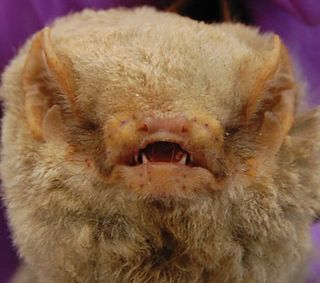
The individual member states of the African Union (AU) coordinate foreign policy through this agency, in addition to conducting their own international relations on a state-by-state basis. The AU represents the interests of African peoples at large in intergovernmental organizations (IGO's); for instance, it is a permanent observer at the United Nations' General Assembly.
The Upper Guinean forests is a tropical seasonal forest region of West Africa. The Upper Guinean forests extend from Guinea and Sierra Leone in the west through Liberia, Côte d'Ivoire and Ghana to Togo in the east, and a few hundred kilometers inland from the Atlantic coast. A few enclaves of montane forest lie further inland in the mountains of central Guinea and central Togo and Benin.
The Lower Guinean forests also known as the Lower Guinean-Congolian forests, are a region of coastal tropical moist broadleaf forest in West Africa, extending along the eastern coast of the Gulf of Guinea from eastern Benin through Nigeria and Cameroon.

The Abo bat is a species of vesper bat in the family Vespertilionidae. It is found in several countries in West Africa and Central Africa. It is found in subtropical and tropical dry and moist lowland forests.

The olive-green camaroptera is a bird species in the family Cisticolidae.

The purple-throated cuckooshrike is a species of bird in the family Campephagidae. It is found in Angola, Benin, Cameroon, Central African Republic, Republic of the Congo, Democratic Republic of the Congo, Ivory Coast, Equatorial Guinea, Gabon, Ghana, Guinea, Kenya, Liberia, Mali, Nigeria, Sierra Leone, South Sudan, Tanzania, Togo, Uganda, and Zambia. Its natural habitats are subtropical or tropical dry forest, subtropical or tropical moist lowland forest, and subtropical or tropical moist montane forest.

The blue-billed malimbe or Gray's malimbe is a species of bird in the family Ploceidae.

The West-Central Africa Division (WAD) of Seventh-day Adventists is a sub-entity of the General Conference of Seventh-day Adventists, which coordinates the Church's operations in 22 African countries, which include Benin, Burkina Faso, Cameroon, Cape Verde, Central African Republic, Chad, Congo, Equatorial Guinea, Gabon, Gambia, Ghana, Guinea, Guinea-Bissau, Ivory Coast, Liberia, Mali, Mauritania, Niger, Nigeria, Senegal, Sierra Leone, and Togo. Its headquarters is in Abidjan, Côte d'Ivoire. Founded in 2003, the division membership as of June 30, 2021 is 889,196

Segmentorbis kanisaensis is a species of air-breathing freshwater snail, aquatic pulmonate gastropod mollusk in the family Planorbidae, the ram's horn snails.
Cuviera is a genus of flowering plants in the family Rubiaceae native to tropical Africa. It was originally described by Augustin Pyramus de Candolle in 1807 and is named after the French naturalist Georges Cuvier.

Appias phaola, the Congo white, dirty albatross, dirty albatross white or plain albatross, is a butterfly in the family Pieridae. It is found in Sierra Leone, Liberia, Ivory Coast, Ghana, Togo, Benin, Nigeria, Cameroon, Equatorial Guinea (Bioko), the Republic of the Congo, Uganda, Ethiopia, Sudan, the Democratic Republic of the Congo, Kenya, Tanzania and Malawi. The habitat consists of primary wet forests.

Appias sylvia, the woodland albatross white or common albatross, is a butterfly in the family Pieridae. It is found in Senegal, Gambia, Guinea, Sierra Leone, Liberia, Ivory Coast, Ghana, Togo, Benin, Nigeria, Equatorial Guinea (Bioko), Cameroon, the Republic of the Congo, the Central African Republic, the Democratic Republic of the Congo, Sudan, Ethiopia, Angola, Namibia, Zambia, Kenya, Uganda, Tanzania and Malawi. The habitat consists of forests.

Nepheronia pharis, the round-winged vagrant, is a butterfly in the family Pieridae. It is found in Sierra Leone, Guinea, Liberia, Ivory Coast, Ghana, Togo, Benin, Nigeria, Cameroon, Equatorial Guinea, the Republic of the Congo, Angola, the Central African Republic, the Democratic Republic of the Congo, Uganda, Kenya and Tanzania. The habitat consists of undisturbed primary lowland forests and riverine forests.
Euphaedra janetta, the Janetta Themis forester, is a butterfly in the family Nymphalidae. It is found in Guinea, Sierra Leone, Liberia, Ivory Coast, Ghana, Togo, Benin, Nigeria, Cameroon, Equatorial Guinea, the Central African Republic and the Democratic Republic of the Congo. The habitat consists of forests.

Euphaedra harpalyce, the common blue-banded forester, is a butterfly in the family Nymphalidae. It is found in Guinea-Bissau, Guinea, Sierra Leone, Liberia, Ivory Coast, Ghana, Togo, Benin, Nigeria, Cameroon, Equatorial Guinea Gabon, the Central African Republic, Angola, the Democratic Republic of the Congo, Sudan, Uganda, Rwanda, Tanzania and Zambia.

Paradeudorix eleala, the western fairy playboy, is a butterfly in the family Lycaenidae. It is found in Guinea-Bissau, Guinea, Sierra Leone, Liberia, Ivory Coast, Ghana, Togo, Benin, Nigeria, Cameroon, Equatorial Guinea and the Democratic Republic of the Congo. The habitat consists of primary forests.
Craterispermum is a genus of flowering plants in the family Rubiaceae. It contains 16 species that occur in tropical Africa and Seychelles. It is the only genus in the tribe Craterispermeae, of which the divergence time is estimated at 34.8 million years ago.

Eresiomera isca, the common pearly, is a butterfly in the family Lycaenidae. It is found in Guinea, Sierra Leone, Liberia, Ivory Coast, Ghana, Nigeria, Cameroon, Bioko, Gabon, the Republic of the Congo, the Central African Republic and the Democratic Republic of the Congo. The habitat consists of forests and swamp forests.
The Guineo-Congolian region is a biogeographical region in Africa straddling the Equator and stretching from the Atlantic Ocean through the Congo Basin to the Congo / Nile divide in Rwanda and Burundi. Formerly, this region was largely covered in rain forest, on both well-drained sites and in swamp forests, but little undisturbed primary forest now remains, having been replaced in many areas by savanna and secondary-growth forest.















